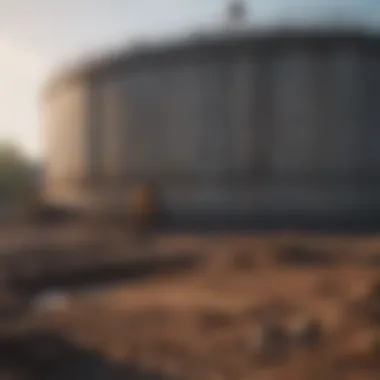Comprehensive Guide to Underground Oil Tank Remediation: Environmental Solutions


Overview of the Topic
Underground oil tank remediation is a crucial environmental procedure that involves addressing issues related to buried oil storage tanks. The significance of this topic lies in the potential environmental impact of oil tank leaks, which can contaminate soil and groundwater. Remediation efforts are essential to mitigate these hazards and prevent further harm to ecosystems and human health.
Current Status and Challenges
Currently, underground oil tank leaks pose a significant threat to environmental health, especially in older properties where aging tanks are prone to deterioration. The challenges faced in this field include early detection of leaks, assessing the extent of contamination, and implementing effective remediation strategies. Additionally, navigating regulatory requirements and compliance standards adds complexity to the remediation process.
Sustainable Solutions
Exploring sustainable solutions for underground oil tank remediation involves adopting proactive measures to prevent leaks and implementing cost-effective cleanup technologies. Effective case studies showcasing successful remediation projects highlight the importance of swift action and adherence to best practices in addressing oil tank pollution. Emphasizing the integration of environmentally friendly practices can lead to long-term sustainability in managing underground oil tank issues.
Impact and Importance
The impact of underground oil tank contamination extends beyond environmental concerns and directly affects communities and future generations. Ecological disruptions caused by oil spills can persist for years, affecting biodiversity and water quality. Recognizing the importance of conserving natural resources and safeguarding the environment underscores the critical role of underground oil tank remediation in promoting a cleaner and safer ecosystem for all.
Introduction to Underground Oil Tank Remediation
In this article, we delve into the crucial process of underground oil tank remediation, a meticulous undertaking that involves addressing and resolving issues related to buried oil storage tanks. This comprehensive guide provides valuable insights into the significance of remediation efforts, shedding light on the environmental impact of oil tank leaks and the techniques utilized to alleviate potential hazards. From the initial assessment stages to the final cleanup procedures, readers will gain a detailed overview of underground oil tank remediation.
Understanding Underground Oil Tanks
The Function of Underground Oil Tanks
Delving into the functionality of underground oil tanks is imperative to grasp their role in the overall discussion on remediation. These structures serve as crucial repositories for storing oil beneath the surface, a key characteristic that aids in efficient storage and management. The encapsulation provided by underground placement is a beneficial choice for this article due to its capacity to secure oil while minimizing visual impact on the surroundings. The unique feature of hidden storage helps in safeguarding the integrity of the stored oil, although challenges such as potential leaks and maintenance drawbacks are also associated with this method.
Issues Associated with Buried Oil Storage


The challenges linked to buried oil storage are paramount in understanding the complexities of remediation efforts. Issues such as leaks, corrosion, and environmental contamination underscore the risks posed by these hidden repositories. Highlighting the inherent risks and vulnerabilities of buried oil storage accentuates why addressing these concerns is crucial for this article. Despite its discreet nature, the practice of storing oil underground poses unique challenges, with advantages like space optimization often overshadowed by the potential hazards it introduces. Balancing the advantages and disadvantages of buried oil storage is a key consideration in the context of remediation efforts.
Importance of Remediation
Underground oil tank remediation plays a pivotal role in safeguarding the environment and human health. The remediation process is essential to address the potential hazards posed by buried oil storage tanks. By delving into the intricate process of remediation, this article sheds light on the critical steps involved in mitigating the environmental impact of oil tank leaks. From initial assessment to final cleanup, every aspect is meticulously examined to provide readers with a comprehensive understanding of the remediation process.
Environmental Impact of Oil Tank Leaks
Contamination of soil and groundwater
Contamination of soil and groundwater is a significant concern associated with underground oil tank leaks. The seepage of oil into the surrounding soil and groundwater can lead to extensive pollution, posing risks to both the environment and public health. Addressing this issue is crucial in preventing further contamination and ensuring the restoration of affected areas. This article elaborates on the detrimental effects of soil and groundwater contamination, highlighting the importance of implementing remediation strategies to mitigate these consequences effectively. By exploring the specific characteristics of contamination and its implications, readers gain valuable insights into the urgency of remediation efforts.
Threats to human health and wildlife
The repercussions of oil tank leaks extend beyond environmental impact, also posing threats to human health and wildlife. Exposure to contaminated soil and groundwater can have profound health implications, making it imperative to address these threats promptly. Wildlife habitats are also at risk, facing potential harm from pollutants released due to oil tank leaks. By addressing the threats posed to human health and wildlife, this article underscores the critical importance of remediation in safeguarding both ecological balance and public well-being. Readers are provided with a detailed analysis of the unique challenges posed by these threats and the significance of remediation in mitigating such risks.
Legal and Regulatory Compliance
Laws governing underground oil tank removal
Compliance with laws governing underground oil tank removal is a central aspect of the remediation process. These laws outline the procedures and requirements for safe tank removal, emphasizing the need for adherence to regulatory standards. By exploring the specific laws and regulations governing tank removal, this article elucidates the legal framework that guides remediation efforts. The discussion delves into the key features of these laws, emphasizing their role in ensuring the proper and safe removal of underground oil tanks.
Penalties for non-compliance
Non-compliance with remediation laws can result in severe penalties, underscoring the importance of regulatory adherence. Failure to comply with established regulations can not only lead to financial penalties but also exacerbate environmental damage. This section highlights the consequences of non-compliance, emphasizing the need for strict adherence to regulatory guidelines. By outlining the penalties associated with non-compliance, readers gain a comprehensive understanding of the repercussions of negligence in the remediation process.
Assessment and Planning


In the realms of underground oil tank remediation, Assessment and Planning emerge as fundamental pillars essential for orchestrating a successful remediation endeavor. This pivotal phase embodies the meticulous groundwork essential for identifying, understanding, and subsequently addressing the looming threats posed by buried oil storage tanks. Assessment endeavors encompass a multipronged approach, featuring various diagnostic techniques, evaluations, and surveys aimed at gauging the extent of contamination and potential hazards prevalent in the site’s ecosystem. Moreover, the Planning facet not only delineates the strategic roadmap for conducting remediation operations but also encapsulates crucial logistical considerations, resource allotment, and regulatory compliance frameworks that steer the entire mitigation process. Importantly, a well-devised Assessment and Planning strategy not only expedites the detection and resolution of underground oil tank issues but also underscores the proactive stance towards safeguarding environmental integrity and public health.
Site Evaluation
Testing for leaks and soil contamination
Testing for leaks and soil contamination epitomizes a pivotal element within the broader spectrum of soil evaluation tactics in underground oil tank remediation. This distinctive procedure seeks to ascertain the presence, extent, and dispersion of oil leakage within the soil adjacent to the tank, thereby furnishing invaluable insights into the scale of environmental contamination. By leveraging specialized diagnostic tools, such as soil probes, sampling kits, and chemical assays, professionals can discern the concentration levels of oil-based contaminants, facilitating informed decision-making concerning subsequent mitigation strategies. The robustness of testing for leaks and soil contamination lies in its non-invasive nature, which minimizes ecological disturbance and offers real-time data acquisition capabilities, enabling prompt remedial action when warranted. However, constraints may arise in accurately pinpointing subterranean leakage sources and delineating contamination boundaries, posing challenges in precise remediation planning.
Determining remediation requirements
At the crux of the site evaluation process resides the critical task of determining remediation requirements, a defining step dictating the remedial approach's scope, complexity, and efficacy. This multifaceted assessment involves a close examination of the data procured from leak testing, soil analysis, and ecological risk assessments, synthesizing a cohesive understanding of the remedial imperatives at play. By discerning the spatial extent of soil contamination, the proficiency of natural filtration processes, and the underlying hydrogeological dynamics, experts can tailor remediation strategies towards optimizing contaminant removal, habitat restoration, and environmental restitution. However, nuances in contamination behavior, soil permeability, and geological stratification may impose uncertainties in precisely gauging the requisite intensity of remediation efforts, warranting iterative evaluations and adaptive planning methodologies to achieve remediation success.
Remediation Techniques
In the realm of underground oil tank remediation, the focus shifts to the pivotal aspect of remediation techniques. This segment of the comprehensive guide holds immense importance in navigating the complex process of tackling issues associated with buried oil storage tanks. By delving into specific elements such as excavation, remediation methods, and cleanup procedures, this section aims to shed light on the significance of utilizing efficient techniques to address oil tank leaks effectively and mitigate potential hazards.
Excavation and Removal
- Digging out the oil tank: Understanding the core process of excavating and removing underground oil tanks is a fundamental pillar in the remediation journey. The act of physically digging out the oil tank from its underground location plays a critical role in initiating the remediation process. This method is favored due to its direct approach in addressing the primary source of contamination. The meticulous excavation process ensures that the tank is safely extracted without causing further environmental harm. While this technique is effective in targeting the root of the issue, it may pose challenges in terms of accessing tightly confined spaces or navigating through heavily contaminated soil.
- Proper disposal of contaminated soil: Another essential aspect of the remediation process is the proper disposal of soil contaminated by leaked oil. This step is integral to preventing further spread of pollutants and safeguarding the surrounding environment. Adopting appropriate disposal methods, such as incineration or secure landfilling, is crucial in ensuring that the contaminated soil is safely contained and eliminated. However, the disposal process must adhere to strict regulatory guidelines to minimize the risk of secondary contamination. Despite its importance in the remediation process, proper disposal of contaminated soil can be a costly and resource-intensive endeavor.
In-Situ Remediation
- Bioremediation techniques: The application of bioremediation techniques represents a sustainable approach to rectifying oil tank leaks in situ. By leveraging the natural capacity of microorganisms to degrade contaminants, bioremediation offers an eco-friendly and effective solution to remediate soil and groundwater pollution. This method stands out for its ability to target pollutants at their source, promoting long-term environmental restoration. However, the success of bioremediation techniques relies on factors such as microbial activity, environmental conditions, and the presence of suitable nutrients.
- Chemical oxidation methods: In contrast, chemical oxidation methods provide a rapid and controlled remediation strategy for mitigating oil tank leaks. By utilizing powerful oxidants to break down contaminants, this approach offers a proactive means of addressing pollution hotspots. Chemical oxidation stands as a versatile option, capable of treating a wide range of pollutants and achieving accelerated results. Nevertheless, careful monitoring is essential to prevent excessive chemical use and unintended environmental consequences.
This detailed exploration of remediation techniques underscores the diversity of approaches available to remediate underground oil tank leaks comprehensively.
Monitoring and Verification


In the realm of comprehensive underground oil tank remediation, Monitoring and Verification stand as crucial pillars ensuring the success and efficacy of the remediation process. Monitoring involves diligent observation and measurement of key environmental factors post-remediation, while Verification aims to confirm the effectiveness of the remediation methods employed. This phase is paramount in ensuring that the remediation efforts have efficiently addressed the issues stemming from buried oil storage tanks, safeguarding both the environment and public health. Proper Monitoring and Verification provide valuable data to assess the remediation's impact and determine if further actions are necessary.
Post-Remediation Assessment
Testing soil and groundwater quality
Testing soil and groundwater quality plays a pivotal role in Post-Remediation Assessment, offering insights into the level of contamination present after remediation efforts. This step involves collecting samples from the soil and groundwater surrounding the former tank site and subjecting them to rigorous testing to determine the presence of residual contaminants. By analyzing the quality of soil and groundwater, environmental professionals can gauge the effectiveness of the remediation methods used and ascertain any remaining risks to the ecosystem and human health. Testing soil and groundwater quality serves as a fundamental indicator of the success of the remediation process, guiding decisions on further remedial actions if needed.
Ensuring effectiveness of remediation
Ensuring the effectiveness of remediation strategies is paramount to the integrity of the underground oil tank remediation process. This aspect involves verifying that the chosen remediation techniques have successfully mitigated the risks associated with the buried oil tank, ensuring that environmental damage has been minimized. By assessing the impact of remediation activities on the soil and groundwater quality, stakeholders can determine the overall success of the remediation efforts. Ensuring effectiveness of remediation is critical for achieving regulatory compliance and demonstrating a commitment to environmental stewardship. However, challenges may arise in assessing the complete eradication of contamination and determining the long-term sustainability of the remediated site, necessitating ongoing monitoring and periodic reviews of the remediation efficacy.
Conclusion
In the realm of underground oil tank remediation, the significance of proper remediation cannot be overstated. It serves as the linchpin in the entire process, ensuring that the environmental and human health impacts of oil tank leaks are adequately addressed. Proper remediation involves a meticulous approach to decontamination and restoration, mitigating the risks posed by buried oil storage tanks. By prioritizing the thorough cleanup of contaminated soil and groundwater, proper remediation plays a crucial role in safeguarding ecosystems and preventing further harm. Compliance with legal regulations and adherence to industry best practices are paramount in achieving successful underground oil tank remediation.
Summary of Key Points
Impact of oil tank leaks
The impact of oil tank leaks extends far beyond surface-level contamination, penetrating soil and groundwater with hazardous substances. This pervasive pollution not only endangers ecosystems but also poses serious health risks to humans and wildlife. Addressing the impact of oil tank leaks is essential in averting ecological disasters and safeguarding the purity of our natural resources. Proper management of leak consequences is critical for preventing widespread environmental degradation and promoting sustainable land use practices.
Significance of proper remediation
Proper remediation stands as the cornerstone of effective underground oil tank cleanup, addressing the root causes of contamination and restoring ecological balance. Its focus on comprehensive decontamination and risk mitigation sets the stage for long-term environmental health and safety. By emphasizing a systematic approach to remediation, stakeholders can ensure that impacted sites are fully restored to their former state. The significance of proper remediation lies in its ability to reverse the adverse effects of oil tank leaks, paving the way for sustainable land usage and resource conservation.
Future Considerations
Advances in remediation technologies
The landscape of underground oil tank clean-up is evolving rapidly, buoyed by advances in remediation technologies that offer more efficient and sustainable solutions. Innovations such as enhanced soil vapor extraction and in-situ chemical oxidation are revolutionizing the remediation process, leading to quicker and more effective outcomes. These technological breakthroughs not only streamline remediation efforts but also reduce the environmental footprint of cleanup operations. Embracing these advances enables stakeholders to tackle contamination challenges more adeptly and proactively, heralding a new era in underground oil tank remediation.
Importance of preventive measures
Prevention remains the most potent weapon in combating the risks associated with underground oil tank storage. Implementing robust preventive measures, including regular inspections and leak detection systems, is crucial in averting costly cleanup endeavors and environmental damages. By integrating preventive strategies into oil tank management practices, stakeholders can nip potential issues in the bud and uphold ecological integrity. The importance of preventive measures lies in their capacity to pre-empt environmental disasters, allowing for early intervention and minimized ecological impact.



